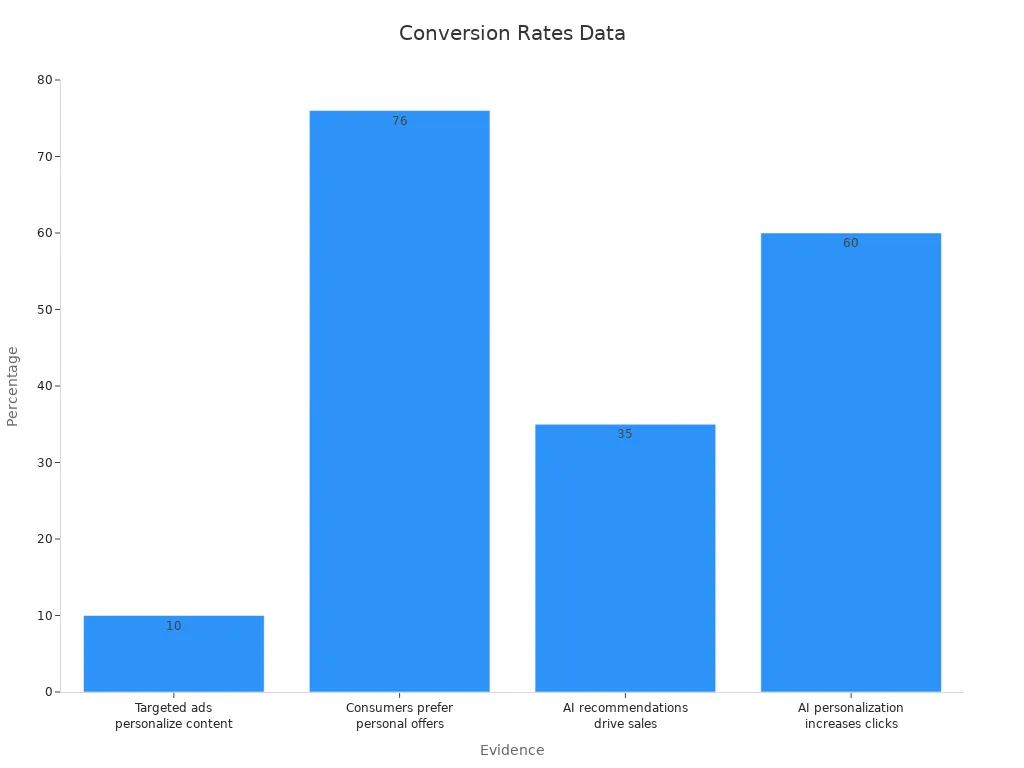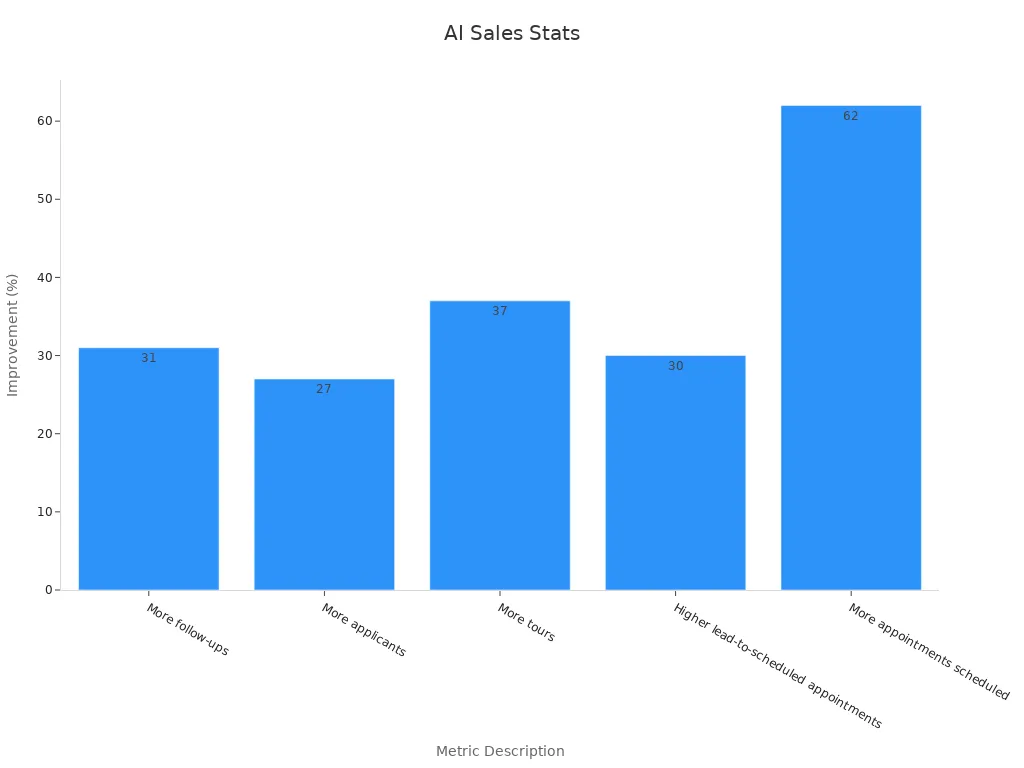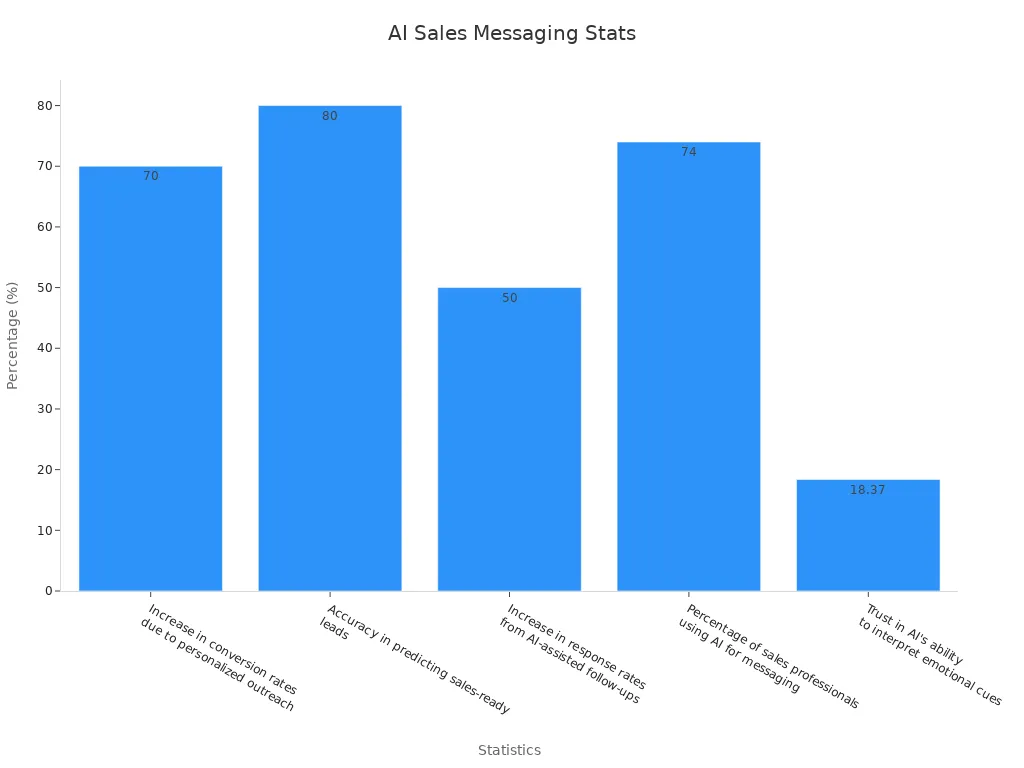Using AI to Personalize Sales Messaging

Making things personal is now key in sales. Did you know 72% of customers only respond to personal messages? Also, 63% of people ignore brands that don’t do this. Using AI helps by creating messages that seem made just for you. This builds understanding and stronger bonds with your audience.
Key Takeaways
Personal sales messages make customers more interested. 72% of people reply better to messages that feel personal.
AI looks at customer data to make custom messages. This helps businesses talk to customers and grow sales by up to 45%.
Mixing AI with human help makes customers happier. Let AI do easy jobs while people solve harder problems to build trust.
What Is AI-Driven Personalization in Sales Messaging?
Defining AI-driven personalization and its impact on sales strategies
AI-driven personalization means using artificial intelligence to create custom experiences. It’s like having a smart helper that knows what customers want. AI studies what people do and like, then makes messages feel personal. This doesn’t just make talking to customers better—it changes how you sell.
Why is this important? Research shows personal messages make customers happier. Companies using AI personalization have kept 33% more customers. They’ve also sold 45% more products to existing customers. When people feel understood, they stay loyal and buy more.
Tip: Think of AI-driven personalization as a way to connect better with customers. It’s not just about selling—it’s about building trust.
How AI leverages customer data to craft tailored messages
AI uses customer data to create messages that fit each person. It looks at things like shopping habits and browsing history. Here’s how it works:
Customer segmentation: AI groups people by what they do, buy, or like.
Content personalization: It picks the best content for each person to see.
Predictive recommendations: AI guesses what someone might want next.
Automated communication: It sends emails and follow-ups at the right time.
Real-time personalization: During live chats, AI helps sales reps adjust their approach.
For example, personalized emails can boost revenue by 760%. AI helps you understand customers and give them exactly what they need.
The role of natural language processing (NLP) in analyzing customer interactions
Natural language processing (NLP) helps AI understand human language. This makes customer conversations more meaningful. Here’s how NLP helps in sales:
Chatbots: NLP powers bots that answer questions quickly, making customers happy.
Sentiment analysis: It finds out how customers feel from their feedback.
Automated response systems: NLP helps reply to common questions fast, saving time.
For example, companies using AI chat assistants have seen a 14% boost in team productivity. By studying words and emotions, NLP makes sure your messages connect with people. Every interaction becomes more valuable.
Benefits of Using AI for Personalized Sales Messaging

Better customer connections with highly tailored communication
AI helps you talk to customers in a personal way. It learns what they like and sends messages that feel special. This keeps customers interested and makes them want to engage with your brand.
For instance, AI uses segmentation to group people by their likes and actions. Check out the table below:
Statistic | Description |
|---|---|
Segmentation helped The Royal Canadian Mint gain many buyers. | |
50% lower CTR | Non-targeted campaigns had fewer clicks than segmented ones. |
3-5% increase in returns | Custom messages improved returns on sales. |
60% better understanding | Companies using segmentation know their audience’s needs better. |
AI also uses machine learning to study customer actions instantly. This lets you send messages at just the right time. Whether it’s an email or chatbot reply, AI makes every interaction feel important.
Did you know? Personalized emails can boost revenue by 760%. That’s the magic of tailored communication!
Higher sales by matching messages to customer needs
AI helps you match your messages to what customers want. This makes them more likely to buy. AI studies things like shopping history and social media activity to make this happen.
Here’s how AI improves conversion rates:
Evidence Description | Statistic | Source |
|---|---|---|
Targeted ads and custom content boost conversion rates | 10% | |
People prefer brands with personalized experiences | ||
AI-powered suggestions drive 35% of Amazon’s yearly sales | 35% | |
AI-driven personalization raised click-through rates at North Face | 60% | N/A |

Picture this: You’re online shopping, and the site shows items you love. That’s AI making your experience smooth and personal. No wonder 76% of people prefer brands with personalized offers.
Time-saving tools for sales teams to focus on key tasks
AI doesn’t just personalize—it saves time too. It handles boring tasks so your team can focus on big goals like closing deals. Here’s how AI makes work easier:
Metric | Description |
|---|---|
Improved Productivity | AI gives sales teams more time for important tasks. |
Better Lead Management | Automation makes finding and qualifying leads simple. |
Smart Lead Prioritization | AI ranks leads so you focus on the best ones. |
Automation of Manual Tasks | Tasks like data entry and follow-ups are done automatically. |

A 2023 study says AI can save about one-third of a workweek. Think of all the extra things your team could do with that time! From scheduling to analyzing data, AI handles the hard stuff so you can close more deals.
Pro Tip: AI not only saves time but also reduces mistakes, making your sales process smoother and more effective.
Best Practices for Using AI in Sales Messaging
Picking AI tools that match your goals and sales needs
Choosing the right AI tools is very important. They should fit your goals and make sales easier. First, decide what you want to achieve. Do you need to save time, connect better with customers, or sell more? Once you know, find tools that meet those needs.
Here’s a simple guide to help you choose:
Description | Impact | |
|---|---|---|
Task Automation | Handles boring tasks like data entry and follow-ups. | Gives your team more time to focus on selling. |
Advanced Analytics | Combines data from different places for better insights. | Helps you make smarter choices and improve your sales. |
Integration Capabilities | Makes sure the tool works with your current systems. | Reduces problems and makes the most of your tech setup. |
Personalization | Creates messages based on what buyers like. | Companies using this see 40% more revenue than others. |
Pro Tip: Test tools before buying them. A trial can show if they work for you.
Connecting AI with CRM systems for better use of data
Your CRM system holds lots of customer information. Adding AI to it gives you great insights. AI can study customer actions, predict trends, and suggest the best times to contact them. This makes selling easier and more effective.
Here’s how AI and CRM together can help:
Find useful insights from big data to make smart choices.
Spot hidden patterns in how customers behave, like buying habits.
Predict what customers might need next or upsell chances.
Study customer feelings from social media and other places.
Check how well your marketing campaigns are working.
To start, make sure your AI tools can work with your CRM. Let them share data easily and check results often. This way, you’ll know if the setup is helping you reach your goals.
Watching and improving AI strategies using performance data
AI isn’t something you set up and forget. To get the best results, you need to check how it’s doing. Looking at key numbers often helps you see what’s good and what needs fixing.
Keep an eye on these metrics:
Close Rates: Check how many leads turn into customers.
Website Traffic: See if your campaigns are bringing people to your site.
Lead Generation Patterns: Learn what grabs your audience’s interest.
Training Metrics: Find skill gaps in your team and offer training.
Note: Improving AI strategies isn’t just about fixing issues. It’s about staying ahead and getting better at sales.
By tracking these numbers and making changes, your AI tools will stay useful and help you reach your goals.
Real-Life Examples of AI-Driven Personalization in Sales

Case study: How Salesforce Einstein improves sales messaging with AI
Salesforce Einstein changes how sales teams personalize messages. It uses machine learning to make selling easier and smarter. Here’s what it does:
Lead Scoring: Einstein checks past actions to rank leads. This helps you focus on the best ones.
Predictive Personalization: It studies customer habits to guess their next move. You can then send messages that fit their needs.
Automated Case Routing: Einstein sends customer questions to the right person. This makes replies faster and keeps customers happy.
These tools help you connect with people in a natural way. It’s like having a smart helper for your sales team!
The effect of AI-powered email campaigns on keeping customers
AI-powered emails are great for keeping customers loyal. They use data to send the perfect message at the perfect time. Did you know AI can improve customer loyalty by 20%? That’s a big deal!
These emails also save money. AI automation lowers customer-getting costs by 49%. At the same time, it boosts lifetime value (LTV) by 60%. Imagine sending emails that not only grab attention but also keep customers coming back. That’s the power of AI at work.
Success stories of using generative AI for LinkedIn outreach
Generative AI is changing LinkedIn messaging. It helps create messages that feel real and personal. For example, AI can write connection requests with details about the person. This makes your messages stand out.
Companies using generative AI see better results, like more replies and connections. Watching numbers like reply rates and conversions helps improve your plan. With AI, you’re not just messaging—you’re building trust and stronger bonds.
Challenges and Limitations of Using AI in Sales Messaging
Handling data privacy issues and following rules
AI in sales messaging uses a lot of customer data. This can cause privacy worries. You might ask, "Is my data safe?" Here are some risks to think about:
Data leaks can happen if security isn’t strong.
AI grows faster than laws, making rules unclear.
Collecting too much data comes with legal duties.
Laws like GDPR require careful data handling. Breaking these rules can lead to big fines and harm your reputation. For example, if someone steals customer data, it could lead to identity theft or money loss. To follow the rules, use strong security and clear policies.
Tip: Check your data practices often. Make sure your AI tools follow the latest rules. This keeps your customers and business safe.
Dealing with the costs and resources for using AI
AI can improve sales, but it’s expensive. Costs can pile up fast, from software fees to better hardware. Here’s what you might spend on:
Category | Cost Details |
|---|---|
Special Software | Paying for licenses and updates for advanced tools. |
LLM Usage | Models like GPT-4 charge $30 per million input tokens. |
Fast Processing | You’ll need strong hardware for quick results. |
Building In-House AI | Hiring experts costs $90,000 yearly, plus training and tools. |
Outsourcing AI Work | Costs range from $70,000 to $220,000 yearly for skilled help. |
Extra Costs | Fixing data issues, hiring staff, and adapting systems can add more expenses. |
Basic AI tools may cost $100 to $1,000 monthly. Advanced systems can go over $5,000. Start small and grow as you see success.
Pro Tip: Outsource or use managed AI services to save money and get expert help.
Keeping a balance between AI and human interaction
AI is great for simple tasks, but it lacks feelings. Imagine a chatbot answering your question but not understanding your frustration. That’s why human interaction is still important.
A French online store had this problem. They used AI for easy questions, which saved time. But customers missed the personal touch. To fix this, they used both AI and humans. AI handled simple tasks, while people solved harder problems. This kept things efficient and personal.
Here’s how to balance AI and humans:
Let AI do simple tasks so your team can focus on real connections.
Use AI data to help your team give better answers.
Make sure switching between AI and humans is smooth for customers.
Note: Train your team to handle tough situations with care. Skilled agents can turn problems into chances to build trust.
AI is changing how sales messages work, making them smarter and personal. It helps increase sales by 70% and finds ready-to-buy leads with 80% accuracy. Still, human creativity is very important. AI makes things faster, but emotions influence 95% of buying choices. Using both AI and human skills leads to success in today’s tough market.
Statistic Description | Value |
|---|---|
Conversion rates rise with personalized messages | 70% |
Accuracy in finding ready-to-buy leads | 80% |
Higher response rates from AI follow-ups | 50% |
Salespeople using AI for messaging | 74% |
Trust in AI understanding emotions | 18.37% |

Tip: Let AI save time, but use human creativity to build trust. Together, they make messages that customers enjoy.
FAQ
How does AI make sales messaging better?
AI studies customer data to make messages feel personal. It guesses what people like, sends messages automatically, and helps you talk to customers in a real way.
Is setting up AI for sales teams hard?
Not really! Many AI tools work well with CRM systems. Start small, try out features, and grow as you see success.
Will AI take over human sales jobs?
No way! AI does simple tasks, but people are needed for creative ideas and solving tough problems. Use AI to help your team, not replace them.
See Also
Writesonic AI And QuickCreator: Content Creation Showdown
Achieving SEO Excellence Using Perplexity AI: An In-Depth Manual
Customizing Blog Posts To Address Startup Audience Requirements
Determining Your Startup's Ideal Audience: A Detailed Process
Unlock Your Skills: Discover SEO Copywriting Tips For Achievement

